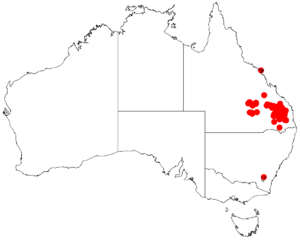Acacia pustula facts for kids
Quick facts for kids Acacia pustula |
|
|---|---|
| Scientific classification | |
| Genus: |
Acacia
|
| Species: |
pustula
|
 |
|
| Occurrence data from AVH | |
Acacia pustula is a type of tree found in northeastern Australia. It belongs to the Acacia family, which is known for its many different kinds of wattle trees.
What it Looks Like
The Acacia pustula tree can grow quite tall, reaching up to 15 metres (49.2 ft), which is about as high as a four-story building! Its branches are smooth and dark reddish, with sharp angles at their ends.
Leaves and Flowers
Like many Acacia species, this tree doesn't have regular leaves. Instead, it has what are called phyllodes. These are flattened leaf stalks that act like leaves. They are evergreen, meaning they stay green all year round. The phyllodes can be long and thin or slightly wider, measuring from 5.5 to 14.5 cm (2.2 to 5.7 in) long and 2 to 14 mm (0.079 to 0.551 in) wide. Younger plants tend to have wider phyllodes than older, more mature trees.
This tree blooms during the winter, usually from May to July. It produces beautiful golden flower-heads that are shaped like small balls. Each flower-head contains about 18 to 25 tiny flowers. These flower-heads grow in clusters along a stem that can be 1 to 9 cm (0.39 to 3.54 in) long.
Seeds and Pods
After the flowers bloom, the tree forms seed pods. These pods are thin, leathery, and mid-brown in color. They are long and straight, but you can see slight bumps where the seeds are inside. The pods can grow up to 12 cm (4.7 in) long and 5 to 7 mm (0.20 to 0.28 in) wide.
Inside the pods, the seeds are arranged lengthwise. They are black and slightly shiny, shaped like an oval or ellipse, and are about 5 to 6 mm (0.20 to 0.24 in) long. Each seed has a small, club-shaped attachment called an aril, which can help with seed dispersal.
Naming the Tree
The scientific name Acacia pustula has a special meaning. The word pustula comes from Latin and means "blister" or "pimple-like." This name was chosen because of a small, raised gland on the edge of the phyllode, which looks a bit like a tiny bump or blister.
Where it Grows
Acacia pustula is endemic to southeastern Queensland, Australia. This means it is only found naturally in this specific area and nowhere else in the world. Most of these trees grow between the towns of Cracow, Condamin, Kingaroy, and Eidsvold. You can also find smaller groups of them in Carnarvon National Park and Salvator Rosa National Park.
These trees prefer to grow in sandy soils, often over sandstone rock. They are usually found in open Eucalyptus woodland communities, which are forests where Eucalyptus trees are the main type of tree.

